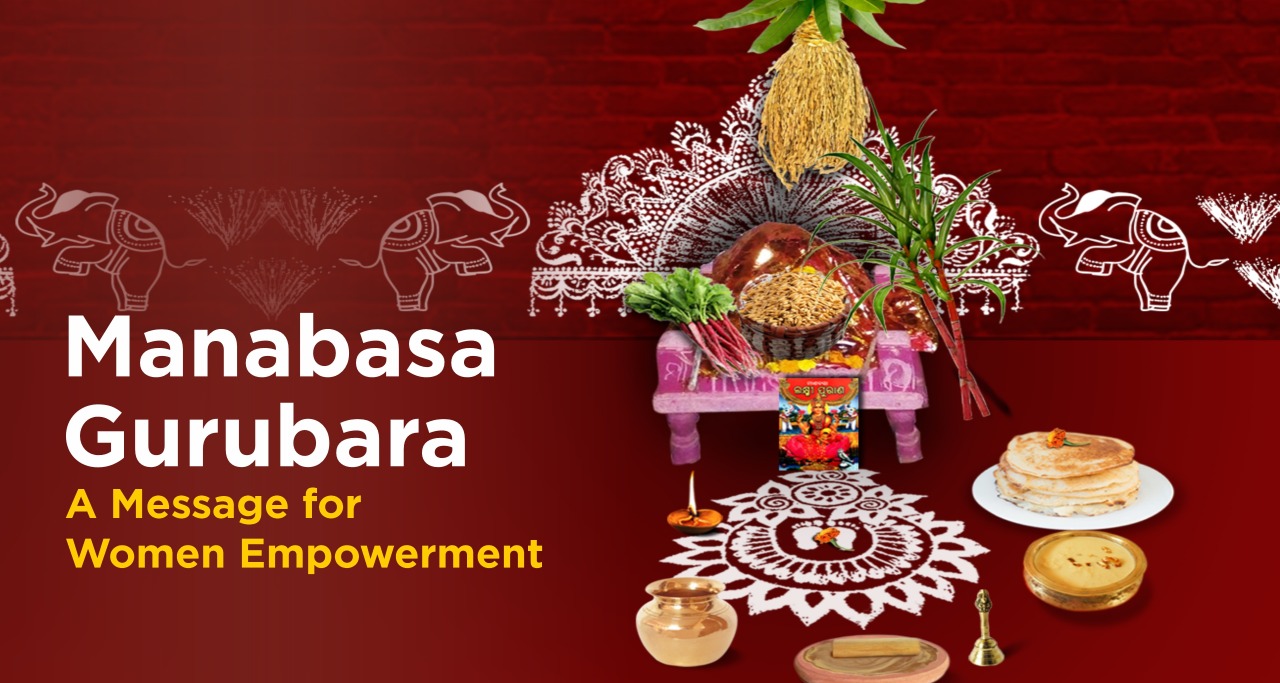Over the centuries Odisha has been home to a treasure of vibrant cultures, heritage, history, folk art, dance & music. Its culture is a classic representation of its incredible history and remarkable cultural diversity. Every festival and ritual of Odisha carries a beautiful history and Odias still observe all the traditions with great pomp and fervour.
When you open your Facebook on a Thursday during the Odia month of “Margasira” (Nov-Dec), your feed will be flooded by beautiful pictures of Jhoti/Chita and Odia women draped in pretty white-red or yellow-red sarees. This is in lieu of the ritual of Goddess Laxmi, Manabasa Gurubara Osa.
The Ritual and Puja Process
Married Odia women observe this annual ritual every Thursday in the Hindu month of Margasira. It is believed that during this month Maa Laxmi visits households that are clean and tidy. She takes away all the suffering and guides one on the path of fame and prosperity. The women wake up early and clean the house to welcome Goddess Laxmi into their homes. The cleaning symbolizes cleansing of minds and hearts specially in relation to discrimination and inequality.
The entrances and thresholds of every Odia home are beautifully decorated with murals or Jhoti made with a white rice paste. The jhoti is embellished by lotuses and little pairs of feet signifying the feet of Laxmi. Odia women drape a red saree around a brass urn filled with freshly harvested paddy and worship Maa Laxmi. They start the worship by reading the Laxmi Purana. This tradition is practised with complete devotion and a variety of Satwik delicacies are made to offer to the goddess.
The diligent and dedicated Odia woman is still carrying on this ancient tradition till date. Be it a homemaker or an office-goer, she manages and organises her tasks perfectly to complete the puja before getting on with other tasks.
Story Behind the Ritual
Manabasa Gurubara is based on the ancient scripture of Laxmi Purana which was written by the great poet Balaram Das in the 15th century. The Purana says the untouchables were not allowed to worship in the temple in ancient times. One fine Thursday Maa Laxmi was strolling around her kingdom when she stumbled upon a neat and tidy home. Curiosity got the better of her and she decided to venture in. However it was the home of an untouchable named Shriya Chandaluni. Lord Balabhadra was displeased by Laxmi’s actions. He accused Maa Laxmi of tarnishing her dignity and asked Lord Jagannath not to let her in. Jagannath tried to convince his elder brother but Lord Balabhadra was adamant. Hearing the words used by him for her, Maa Laxmi felt extremely insulted and she decided to leave Srimandira. Before leaving the temple, Maa Laxmi accused the two brothers of being devoid of “Shree” or wealth and prosperity.
On the next day, the two brothers were dumbfounded when they woke up to a desolate Srimandira. The “Lords of the Universe” ventured onto the streets to beg and feed themselves. But whatever they touched vanished into thin air, and eventually they were labelled “Laxmi Drohi” by the townsfolk.
The two brothers, suffering from days of hunger and thirst finally arrived at Maa Laxmi’s new palace. Realizing their mistake Lord Jagannath tried to convince Shree Laxmi to return to her home, the Srimandira. She placed one condition for her return and Lord Jagannath happily agreed. Maa Laxmi had requested her husband to remove discrimination on the basis of caste among his devotees. And ever since casteism and discrimination have been looked down upon by the Jagannath culture.
This story is told for generations by mothers to daughters and daughters-in-law to teach them about inclusivity and self-empowerment while condemning casteism and discrimination. The Laxmi Purana is a tale of social equality and harmony and it has been read in Odia households for centuries now. The tale has also been represented in movies and TV series. The tale of Maa Laxmi and her struggle against a patriarchal society empowers her devotees and resists male hegemony.
To get a clear view of this ritual you can switch on the local Odia channel during Margasira month to watch the serial based on this subject or you can watch the famous multi-lingual movie Shri Jagannath.
Over the centuries Odisha has been home to a treasure of vibrant cultures, heritage, history, folk art, dance & music. Its culture is a classic representation of its incredible history and remarkable cultural diversity. Every festival and ritual of Odisha carries a beautiful history and Odias still observe all the traditions with great pomp and fervour.
When you open your Facebook on a Thursday during the Odia month of “Margasira” (Nov-Dec), your feed will be flooded by beautiful pictures of Jhoti/Chita and Odia women draped in pretty white-red or yellow-red sarees. This is in lieu of the ritual of Goddess Laxmi, Manabasa Gurubara Osa.
The Ritual and Puja Process
Married Odia women observe this annual ritual every Thursday in the Hindu month of Margasira. It is believed that during this month Maa Laxmi visits households that are clean and tidy. She takes away all the suffering and guides one on the path of fame and prosperity. The women wake up early and clean the house to welcome Goddess Laxmi into their homes. The cleaning symbolizes cleansing of minds and hearts specially in relation to discrimination and inequality.
The entrances and thresholds of every Odia home are beautifully decorated with murals or Jhoti made with a white rice paste. The jhoti is embellished by lotuses and little pairs of feet signifying the feet of Laxmi. Odia women drape a red saree around a brass urn filled with freshly harvested paddy and worship Maa Laxmi. They start the worship by reading the Laxmi Purana. This tradition is practised with complete devotion and a variety of Satwik delicacies are made to offer to the goddess.
The diligent and dedicated Odia woman is still carrying on this ancient tradition till date. Be it a homemaker or an office-goer, she manages and organises her tasks perfectly to complete the puja before getting on with other tasks.
Story Behind the Ritual
Manabasa Gurubara is based on the ancient scripture of Laxmi Purana which was written by the great poet Balaram Das in the 15th century. The Purana says the untouchables were not allowed to worship in the temple in ancient times. One fine Thursday Maa Laxmi was strolling around her kingdom when she stumbled upon a neat and tidy home. Curiosity got the better of her and she decided to venture in. However it was the home of an untouchable named Shriya Chandaluni. Lord Balabhadra was displeased by Laxmi’s actions. He accused Maa Laxmi of tarnishing her dignity and asked Lord Jagannath not to let her in. Jagannath tried to convince his elder brother but Lord Balabhadra was adamant. Hearing the words used by him for her, Maa Laxmi felt extremely insulted and she decided to leave Srimandira. Before leaving the temple, Maa Laxmi accused the two brothers of being devoid of “Shree” or wealth and prosperity.
On the next day, the two brothers were dumbfounded when they woke up to a desolate Srimandira. The “Lords of the Universe” ventured onto the streets to beg and feed themselves. But whatever they touched vanished into thin air, and eventually they were labelled “Laxmi Drohi” by the townsfolk.
The two brothers, suffering from days of hunger and thirst finally arrived at Maa Laxmi’s new palace. Realizing their mistake Lord Jagannath tried to convince Shree Laxmi to return to her home, the Srimandira. She placed one condition for her return and Lord Jagannath happily agreed. Maa Laxmi had requested her husband to remove discrimination on the basis of caste among his devotees. And ever since casteism and discrimination have been looked down upon by the Jagannath culture.
This story is told for generations by mothers to daughters and daughters-in-law to teach them about inclusivity and self-empowerment while condemning casteism and discrimination. The Laxmi Purana is a tale of social equality and harmony and it has been read in Odia households for centuries now. The tale has also been represented in movies and TV series. The tale of Maa Laxmi and her struggle against a patriarchal society empowers her devotees and resists male hegemony.
To get a clear view of this ritual you can switch on the local Odia channel during Margasira month to watch the serial based on this subject or you can watch the famous multi-lingual movie Shri Jagannath.





